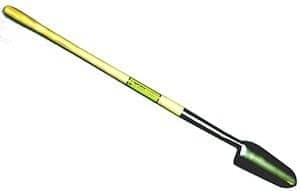
Eventually you will realise that your shovel can be more useful than just carving a slice into the earth. For example, sometimes I may spin it around and use the D-handle to pack down the soil around the plug in hard-to-get-to spots. Another frequent use is to prod with it. Especially if you are in rocky ground. Rather than slam blindly, hoping your blade will penetrate deep enough in the first try, which in rocky ground can lead to tendonitis in your wrist or elbow (I knew one guy who dislocated his entire shoulder pounding his shovel into the ground – and it was only slightly hard clay!), prod with your shovel to get an idea of the ground structure beneath it. Based on the vibration shooting up the staff, through the handle and into your arm, over time you will get a feel for what the soil is like underneath. If most of the ground is soft, by all means, slam the blade in every time. If it is a mixture and too often you find your joints pulsating with pain, be more careful and prod in advance. Once you do find a juicy spot, you do not necessarily need to raise your shovel again to plough it in but you can wriggle it in as explained in the next section, and use your kicker if you have to.
Either way, whether you prod or are confident enough in the terrain to slam in the blade, you should not grip the handle too firmly but let it go ever so slightly just before impact, to prevent an excessive transfer of vibrations and impact energy up into your arm. Avoid tendonitis at all costs.


Next: |
We are a family operation managing private custom boat tours in the beautiful Palawan area, and are happy to help travelers with their plans through the country, having traveled a lot of it ourselves and planning to visit it all. The pages in this section concern when I was treeplanting in Canada over eight summers.
